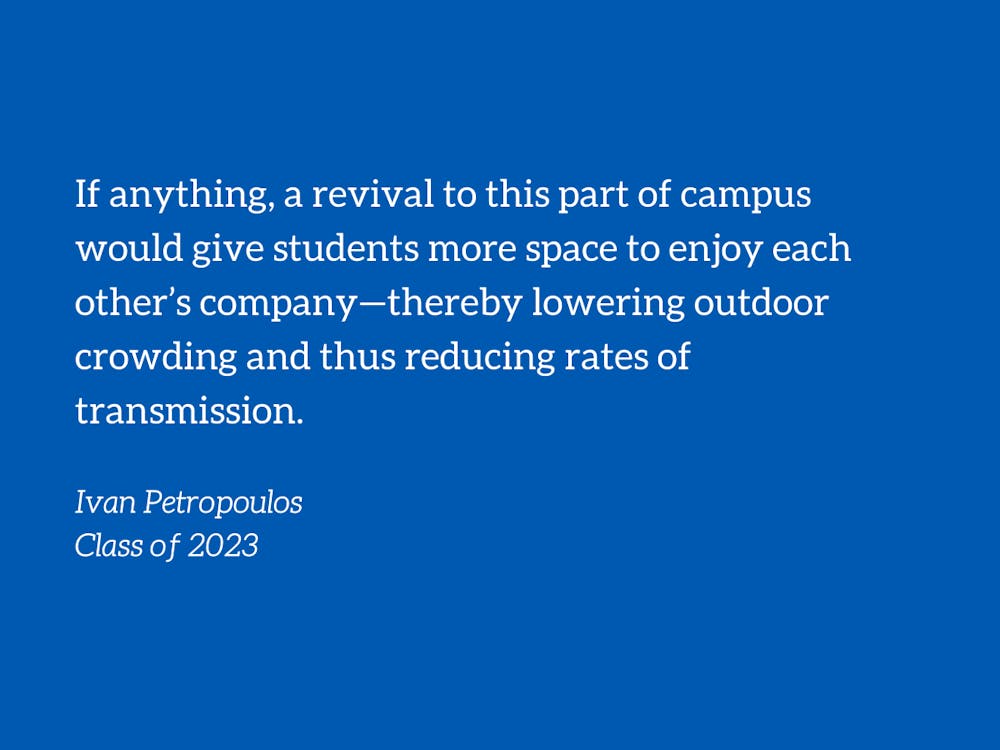It’s Sunday, January 24, 2021. After a mild Carolina winter, life is beginning to reawaken at Sarah P. Duke Gardens. Though the arrival of spring is months away, a number of plants and animals dear to the Duke community have already begun to rise from their slumber. Plumes of color warm the landscape as glowing red camellias and sunny yellow winterhazels come into bloom. Blue jays paint the sky with their song while eastern gray squirrels scavenge the dew-covered grounds below. Everything seems to be in place, but one creature is notably absent: the Duke student.
Since the pandemic’s outbreak in March, Duke students have been barred from entering the gardens as a measure to curb the spread of Covid-19. Even as thousands were permitted to return to Durham in August, university officials deemed the grounds unsuitable to reopen—a position the university maintains going into the spring semester. Although cases have recently reached an all-time high in Durham and across the country, we’ve learned tremendous amounts about the nature of the virus, ourselves and our community. With this in mind, it’s time for university admin to restore student access to Duke Gardens.
One of the most important things we’ve learned about the virus is that it is much harder to transmit in outdoor spaces. Due to better air circulation, and because people tend to distance themselves more when outside, a review of 21,099 Covid-19 infections found that only 7% were caused by outdoor exposure. This, of course, is nothing new to the university: it’s why indoor dining at WU was first limited and then fully restricted this past semester; it’s why you could never find an empty seat at BC Plaza; it’s why we saw Abele and Baldwin quads spike in popularity while most common rooms around campus looked deserted. Opening up the gardens to students is both in-line with what we know about the virus as well as the lifestyle we’ve adopted to combat it. If anything, a revival to this part of campus would give students more space to enjoy each other’s company—thereby lowering outdoor crowding and thus reducing rates of transmission.
Perhaps more importantly, the past semester has taught us a lot about online learning and the impact it has upon students. Going into the pandemic, no one could have predicted the immense mental and physical toll we would face as we tried to live our lives virtually. Only after months of stumbling through courses on Zoom, Sakai and Gradescope has it become apparent that most of us are utterly incapable of spending our entire day, week after week, staring at a computer screen. This comes at no fault of our own: when discussing recent human evolution, acclaimed paleontologist Stephen Jay Gould once famously proclaimed that “[there’s] been no biological change in humans in 40,000 or 50,000 years.” While the absolute nature of this claim has been disputed, it still offers insight as to why we struggle so much in our current situation. Genetically identical to our ancestors who hunted and gathered a few millennia ago, we’re simply not engineered for such a sedentary, artificial and isolated lifestyle. Several studies have already taken note of this phenomenon. For example, a study of over 40,000 adolescents in the US found that heightened screen time resulted in lowered rates of curiosity, self-control and emotional stability as well as increased rates of depression, anxiety and other psychological issues. By contrast, numerous studies have found that increased access to outdoor areas results in higher probabilities of mental and physical wellbeing. Zoom fatigue and other forms of online burnout may not disappear until after the pandemic, but in the meantime, it seems like time spent in the gardens and other outdoor areas would greatly mitigate some of their worst symptoms.
Finally, after being rushed away from one another last spring, after a summer of solitude, and after a semester unlike one ever seen before, we’ve had to come to intimate terms with how indispensable the Duke community really is. Most of us have realized that we need each other more than we ever could have imagined. This is why so many made the tough decision to migrate back to Durham in August—even as Covid-19 cases climbed and it became apparent that nearly all of our classes could be attended remotely. This is why more of us are coming back in the spring. In “unprecedented” situations, it’s essential to connect with people in similar predicaments. Right now, the safest place to do so is in open, outdoor settings like Duke Gardens.
As a university we’ve met nearly every challenge asked of us thus far. Duke has led the nation in its response to the pandemic. Testing, contact tracing, and other administrative policies have played a huge role in setting us apart from our rivals, but so has our student body. We’ve responsibly worn face coverings, socially distanced and held each other accountable. We’ve exchanged traditions like LDOC and Countdown to Craziness for long periods of quarantine. We’ve foregone communal Marketplace dinners, crowded common room events and so many other formative experiences with one another. Opening up the gardens may seem like an unnecessary or even reckless move for some, but without a safe setting to get to know each other and the university, the very core of what makes us Duke may be at stake.
Ivan Petropoulos is a Trinity sophomore. His column runs on alternate Tuesdays.
Get The Chronicle straight to your inbox
Signup for our weekly newsletter. Cancel at any time.

